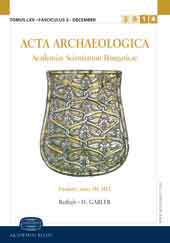LE TAU – UN ATTRIBUT OU UN INSIGNE LITURGIQUE ?
THE TAU – AN ATTRIBUTE OR LITURGICAL INSIGNIA?
Author(s): E. DĄBROWSKASubject(s): Archaeology, Cultural history, Regional Geography, 6th to 12th Centuries
Published by: Akadémiai Kiadó
Keywords: Tau Cross; authority of the bishop; cane; ‘Rabdos;
Summary/Abstract: The head of the Tau Cross indicating the authority of the bishops over earthly matters originates from texts and archaeological finds dating from the 7th century. It originally took the form of a curved wooden cane. From the beginning of the 8th century there also emerged a cane with a horizontal finish in the form of the letter ‘T’ – Tau. Up to the present time there exist thirty-three examples of the Tau form made from elephant ivory , walrus ivory, bronze or wood. These were found in England , Ireland , Scandinavia, France, the German Empire, Poland and Portugal. They all originate from the period between the 8th and 12th centuries but most of them are from the 11th and first half of the 12th century. While the origins of this form of Tau Cross are not entirely clear it undoubtedly has its roots in antiquity but not from the Byzantine period where the prelates used a different type of cane altogether known as a ‘Rabdos’.
Journal: Acta Archaeologica Academiae Scientiarum Hungaricae
- Issue Year: 58/2007
- Issue No: 2
- Page Range: 341-363
- Page Count: 23
- Language: French
- Content File-PDF

